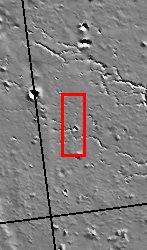- Original Caption Released with Image:
-

(Released 3 July 2002)
Off the western flank of Elysium are the Hephaestus Fossae, including linear arrangements of small, round pits. These features are commonly called "pit chains" and most likely represent the collapse of lava tubes. Lava tubes allow molten rock to move long distances underground. When the lava drains out it leaves unsupported tunnels, which can collapse and form pits. These particular pit chains are unusual because they change direction abruptly. In the lower portion of the image, pits have collapsed at the bends and allow us to observe the sharp, nearly right angle corners. These direction changes are most likely due to some sort of structural control during the emplacement of the lava tubes.
There is an extraordinarily high concentration of small, degraded craters on the plains surface. The size range of these craters is fairly consistent and they all appear to be of similar age. It is unlikely that these were caused by primary impacts (impacts of meteors onto the surface) because both the size and timing distributions of primary impactors vary tremendously. However, the craters in the image could have been created from secondary impacts. Secondaries are impacts of material that is excavated during a large cratering event nearby or from the disintegration of a primary meteor in the atmosphere into many smaller parts that rain onto the surface.
In contrast to these older, small craters, there is a relatively young crater in the center of the image. A hummocky ejecta blanket is visible around the crater and has covered some of the smaller craters on the plain around it. The edges of the crater are sharp, formed by rocky material in the crater rim. This material is visible as the layer of rough, grooved material at the top of the inside walls. Small dust avalanches have left dark streaks down the inside walls of the crater.
- Image Credit:
-
NASA/JPL/Arizona State University
Image Addition Date: -
2002-07-03
|

 Planetary Data System
Planetary Data System













